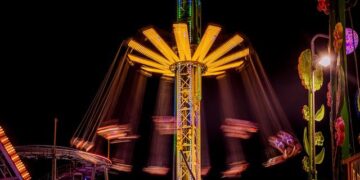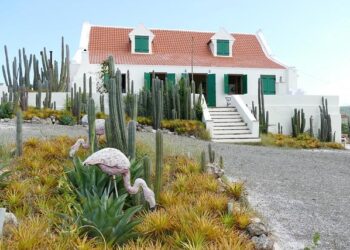Travel
Life plays out much as it always has on the great plains of Kenya’s Maasai Mara, but the latest generation of Maasai are gradually changing the face of modern safari — with greater empowerment for female guides and local communities as a whole.
BySarah Marshall
Published November 19, 2023
• 20 min read
This article was produced by National Geographic Traveller (UK).
Fur still damp and matted from his birth moments earlier, the disorientated youngster wobbles forward, driven by instinct to gain strength through his mother’s milk. She’s standing just a few steps away, exhausted from having carried her cargo for almost nine months through the grassy plains and stumpy whistling thorn acacias of the Naboisho Conservancy. Predators such as lions, cheetahs and leopards roam this reserve in the Greater Mara, near the border with Tanzania in southwestern Kenya.
But now’s no time for rest. Lured by the scent of this vulnerable new life, a pack of black-backed jackals slink from the shadows of the long grass, forcing the new family to shift gear with surprising speed. The mother’s head swings quickly to face them, her tawny ears thrust forward like a pair of satellite dishes, and then both her and her young son are off — galloping towards the rest of their herd a few miles away in the distance, lost in a cloud of ochre dust. Thanks to those lanky legs, honed over hundreds of thousands of years of evolution, even a young wildebeest can survive out here on the plains from day one.
Dramas like this unfold daily across the Mara ecosystem — which encompasses the government-run reserve famous for hosting the Great Migration, when millions of animals arrive from Tanzania in search of fresh pasture, as well as some surrounding community-owned land. But many of these dramas take place without anyone ever knowing. Unless you have a skilled guide to point them out to you, that is. With me is Raphael Lesisa, a local Maasai guide, who’d spotted the heavily pregnant wildebeest minutes before she gave birth in front of us. He grew up in this area and has a well-honed talent for reading the landscape and the animals that reside here.
As we drive off in search of more wildlife, the wheels of our vehicle bumping down the dirt road, Raphael fills me in on some of the local traditions. Pastoralists, he says, will never graze their cattle in an area where wildebeest have given birth, due to their belief that the embryonic sac releases toxins into the soil. Raphael adds that he’s eagerly awaiting the return of the migratory storks, which haven’t arrived yet due to a lack of rain. Kenya is experiencing its worst drought for 40 years, amid its sixth consecutive failed rainy season.
I ask how he learned to read the bush so well. “It’s easy for us Maasai,” he says, shrugging from behind the wheel, adding that he grew up thinking tourists were mad for visiting the Mara and paying money to watch the animals he sees every day for free. “Since we were children, we’ve always been taught how to read the animals and how to look after them. I quickly learned the best way to escape a buffalo — you have to climb a tree,” he says, laughing. “My forefathers knew how to avoid elephants by checking the direction of the wind and staying downwind of them — this prevents them from picking up your scent — and that you should never run away or turn your back on a lion, as it’ll see you as prey,” he adds.
While the in-depth knowledge of the Maasai has been called upon since safaris first arrived here decades ago, it’s only recently that its value has translated into greater rewards: for the Maasai, guiding has turned into a career that can offer proper remuneration and opportunities for advancement in return for their expertise. This is all part of a much broader change sweeping across the region, bringing the industry into the 21st century — with carbon-neutral camps and female guides also leading the charge towards a new kind of safari. Here in Naboisho, much talk revolves around the newest conservancy, the Pardamat Conservation Area, an hour’s drive to the north, and its forward-thinking new guiding school, which opened earlier this year.
Guiding light
Raphael — like the 400-odd other guides currently working in the Mara — studied at the Koiyaki Guiding School, in the Naboisho Conservancy, which opened in 2005 to offer local young people the chance to gain well-paid jobs in tourism.
Since then, a growing movement to set up conservancies via the Maasai Mara Wildlife Conservancies Association has emerged as a way of securing much-needed land for wildlife while improving local livelihoods at the same time. Landowners register their land as conservation areas and receive lease payments, employment opportunities and other benefits as a result.
Pardamat is the next chapter — it’s unique in that it’s now the only Mara conservancy that works via a mixed-use model, where wildlife and communities coexist on its rocky hilltops overlooking the great plains. The conservancy’s 850-plus landowners chose to remain here to live and work — unusual in a region where human-wildlife conflict is on the rise — opting to implement management techniques such as installing predator-proof fences to protect livestock. Pardamat is showing how wildlife and communities can live side by side.
And now, on land donated by the community, it’s the location for the new Wildlife Tourism College (WTC), which opened this year to do the same job as Koiyaki — to train the next generation of local guides. I meet WTC’s general manager, Geoffrey Bob Ouma, for a tour. Featuring an open kitchen, a dining area and a computer room set in an observation tower, the high-tech glass-and-steel building offers an experience that’s a world away from local school studies, which are typically conducted beneath shady trees.
Pointing to the horizon, where the roofs of houses glitter in the sun, he runs me through the catalogue of challenges facing the Maasai today: growing populations living in rapidly expanding towns and cities; grazing areas for livestock shrinking due to drought; and competition between wild animals and people for natural resources encouraging more wildlife to move to places where people live, and vice versa.
“We want to train the next generation so that they don’t just have to rely on keeping cattle and following the traditional ways,” says Geoffrey. “Of course, culture is part of us — this is more about diversifying so they can have a different source of income, and value conserving the environment in the process.”
Courses at the WTC cover all aspects of hospitality — from room stewards to receptionists — as well as environmental management and guiding. There’s space for 40 students from the local community, all sponsored by various tourism companies.
One of the key players was Asilia Africa, which was involved in setting up Koiyaki in 2005 and is now working closely with the WTC in Pardamat. Guides who go on to work with Asilia are offered benefits that are still quite rare in the Mara, including health insurance. I’m staying at the company’s Encounter Mara Camp in Naboisho, which offers guests a behind-the-scenes look at conservation via tours of the college and Pardamat itself.
Hidden within a warren of tunnels cut into a mass of thick bushes that overlook the plains, the camp is made up of simple, expedition-style canvas tents with bucket showers — the focus is very much on the wild surroundings.
While the camp is circled by an electric fence to prevent destruction by bulldozing elephants, it still receives a parade of four-legged visitors, among them genets, porcupines and even big cats.
Early one morning, I’m woken by the sound of lions roaring. It’s so loud that it’s clear Raphael and I won’t have to travel far from camp to catch a glimpse of them. We find them near the mess tent, where buffet lunches are served daily. No doubt seeking sanctuary from her male suitors, a lioness has brought her tiny cubs with her, having somehow managed to sneak in. She spends the day sleeping under a bush close to one of the guest tents.
“I was frightened of lions when I was small,” says Raphael as we sit in a car watching the cubs rolling and tumbling in the morning light. “People in my community would kill male lions as a rite of passage, to show their strength. But all of that stopped when the conservancy model came in — Maasai communities realised they could benefit from wildlife tourism.”
Green season
The following day, my first stop is Emboo River Camp, a modern affair located on the banks of its namesake river inside the Maasai Mara National Reserve, an hour’s drive to the west. Members of a local Maasai community greet me, inviting me to experience how their culture is passed down through the generations via singing and dancing — very little is ever written down, they explain.
Wrapped in red chequered shukas (woollen cloaks) and wearing sandals made from recycled tyres, the young warriors, known as morans, carry beaded fimbos — wooden spears used to shepherd livestock and see off wild animals. Their songs range from tales of cattle raiding to ceremonial pleas for rain, and are followed by a jumping competition. Bouncing higher and higher, their belts of silver discs jingle and glint in the flickering flames, it’s a ritual that demonstrates strength — and hopefully also attracts a wife.
Emboo (a name that means ‘pride’ in the Maasai language, Maa) opened in 2020 as the first carbon-neutral camp in the Mara. Its owners, young Belgian couple Valery Super and Loic Amado, who now live in Nairobi, were inspired to set up the project after being disappointed by the negative impact of some of the other camps in the Mara — which they say can have noisy diesel-powered generators and discard wastewater into rivers.
Much of the property has been built from recycled materials. As I explore, I spot a bar with walls made from recycled Tetra Pak cartons, paving slabs fashioned from waste plastic and rooftops crafted from sustainably sourced wood. A colourful chart on display at the camp’s entrance calculates how much carbon is saved in every area of the business — citing everything from the four solar-powered cars to the laundry washed by hand using non-toxic, herb-based products made by a company called Grounded. Even the rain showers in the guest rooms — luxury safari tents filled with handmade furniture from local artisans — are powered by the sun.
On one of the routine tours of the camp’s green facilities, guest relations manager Joseph Kakonzo shows me a lagoon where wastewater is filtered using native plants, and explains how the complex system of copper and titanium plates used to clean a swimming pool works. “It’s so free from chemicals, you don’t need to wear goggles,” he says with a smile. Next we pause in a workshop where empty wine bottles are recycled to make drinking glasses and waste is separated for recycling.
Sitting down to lunch on a table next to the river, I tuck into a silky massaman curry made with coconut, carrot and yarrow root. All meals served at Emboo are plant-based — although meat additions can be requested — and many ingredients are grown in the camp’s vertical garden, where herbs and leafy greens are cultivated in slender towers to save space and produce a greater yield. The menu has been designed by chefs at trendy farm-to-table restaurant Cultiva in the capital, Nairobi, and artisanal Kenyan brands like 254 Brewing (craft beer) and Spring Valley Coffee are served at the bar.
The next morning, I wake up to rain, which has transformed the pathways into thick mud. Drops of water shimmer like crystals on the spiders’ webs decorating the bush as I set off on my first game drive. I’m with young guide Geoffrey Karia, who’s remarkably fresh faced given how early we’ve set off — the sun is just rising over the plains. He’s dressed in a puffer jacket and jeans — a stark contrast to the starched uniforms at many other safari camps — and as we manoeuvre over the sticky terrain, he tells me what inspired him to go into conservation. It was a talk given by a guide at another camp when he was eight years old — he was visiting with school.
Next to him is trainee Brenda Senewakorian, whose long, plaited hair is swept into a bun. She’s one of several new female guides recruited by Emboo in an effort to bolster their numbers. Traditionally in rural communities, women would be expected to cook and fetch water, among other domestic chores. Now, female guides behind safari vehicle steering wheels are an increasingly common sight in the Mara — largely due to communities becoming more accepting, greater education from initiatives such as the WTC and greater flexibility from employers around family commitments. “Animals are just like us,” she says, her eyes glued to her binoculars. “They just want to take care of their young ones.” She’s a single mother who relies on the support of her family to help raise her child, but she says she’s determined to earn her own income.
She catches sight of two male lions further up the dirt track silhouetted against the horizon, their manes growing bright in the amber light — unlikely halos for the pair. Geoffrey explains that they’re tracking a herd of buffalo over the granite boulders up ahead, and soon its clear they’ve identified a calf that’s been separated from its mother. Both of them make a beeline for the animal, and with one lazy swipe of a paw, their breakfast is served. As one clamps his jaws around its throat, the other licks the calf’s fur greedily.
Maasai matriarchs
Across the Mara, more camps are employing women — including larger operations such as Olonana, just over an hour’s drive north, where glass-fronted rooms overlook the Mara River on the border of the Mara Triangle, shielded by forest from the road. They’re in the process of training their first female guide when I arrive.
When I get there, I’m ushered beneath a grove of acacia trees, where a Maasai welcoming ceremony awaits. Chanting, two Maasai matriarchs, known in Kenya as ‘mamas’, sprinkle water over me and place a beaded garland around my neck, dubbing me Ndali — a Maa word meaning ‘bringer of rain’. They hope the rainy season will be plentiful.
Next, I head out on a game drive with 24-year-old fledgling guide Sofie Rasio, who’s quiet with a broad smile, and her mentor Anthony Lekumok Olempikas, who’s a veteran in the Mara and showing her the ropes. The area is prime wildebeest habitat during peak migration season, but we’re searching for black rhino; this is one of the best, and possibly only, places in the area to see them.
“Girls couldn’t go to school before,” says Sofie as we trundle along the dirt road, Anthony at the wheel. She was born in Olonana village, which is next to the camp. “Our parents thought it would be a waste of money because we’d just end up married and would have to stay at home to raise a family. But the elders understand now that what I do is work, and that everyone needs to contribute to the family income now that life is more expensive. The mentality has changed: if men can drive, we can drive; if men can guide, we can guide, too.”
It’s not long before we find a mother rhino and her calf hiding in the long grass. Unlike white rhinos, which tend to stick to the plains, black rhinos are more elusive. Using the ‘guide magic’ he’s acquired throughout his career, Anthony transforms animal encounters such as this into a soap opera and Sofie listens carefully to the plot lines. As we watch them, he tells us of the legendary black rhino called Mary, who spawned a new population of the creatures in the area and inspired the Kenyan government to establish a protection project.
“When she was orphaned by poachers, Mary lived with a herd of buffaloes and then moved to a group of elands who accepted her,” he says, as if reading a bedtime story. “She disappeared, and brought back a boyfriend.”
Next, we drive as far as the border with Tanzania in search of a group of lions known as the ‘Egyptian pride’. Rays of saffron light filter through the clouds and reflect off pools of water. Eventually, we find them padding between terracotta termite mounds. Sofie watches as the cats give chase to warthogs, enraptured by a scene that’s played out here for countless generations. While the essence of safari may remain the same — of watching wildlife out on the plains — change is coming to Kenya, as the next generation of Maasai guides forge their own path.
Getting there & around
Fly direct from Heathrow to Nairobi with British Airways and Kenya Airways.
Average flight time: 8h45m.
Other airlines such as Ethiopian Airlines, Air France and Emirates also fly via their respective hubs. Air Kenya and Safari Link operate flights to the Mara from Wilson Airport.
When to go
The Great Migration passes through the Mara between July and October — peak season, when lodge prices are highest. The long rains typically fall between March and May, while the short ones come in November and December. In winter, between June and September, temperatures can fall to 11C. Throughout the year, wildlife sightings are excellent. The shoulder season months of March and November are good options for lower prices.
Where to stay
Encounter Mara, Naboisho. From $374 (£296) per person, full board. Emboo River Camp, Maasai Mara National Reserve. From $1,100 (£870) per person, full board. Olonana Safari Lodge, Mara Triangle. From $900 (£720) per person, full board.
More info
Magical Kenya
How to do it
Abercrombie & Kent has a seven-night trip, with two nights at Asilia Encounter Mara, Olonana and Emboo each and one night in Nairobi, from £6,999 per person, full board, including flights, transfers and fees.
This story was created with the support of Abercrombie & Kent, Emboo River Camp and Asilia Africa.
Published in the November 2023 issue of National Geographic Traveller (UK).
To subscribe to National Geographic Traveller (UK) magazine click here. (Available in select countries only).
>>> Read full article>>>
Copyright for syndicated content belongs to the linked Source : National Geographic – https://www.nationalgeographic.com/travel/article/how-maasai-communities-are-empowering-women-in-kenya































